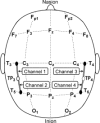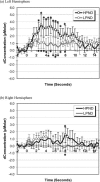Examining the phonological neighborhood density effect using near infrared spectroscopy
- PMID: 20690126
- PMCID: PMC3039710
- DOI: 10.1002/hbm.21115
Examining the phonological neighborhood density effect using near infrared spectroscopy
Abstract
Phonological density refers to the number of words that can be generated by replacing a phoneme in a target word with another phoneme in the same position. Although the precise nature of the phonological neighborhood density effect is not firmly established, many behavioral psycholinguistic studies have shown that visual recognition of individual words is influenced by the number and type of neighbors the words have. This study explored neurobehavioral correlates of phonological neighborhood density in skilled readers of English using near infrared spectroscopy. On the basis of a lexical decision task, our findings showed that words with many phonological neighbors (e.g., FRUIT) were recognized more slowly than words with few phonological neighbors (e.g., PROOF), and that words with many neighbors elicited significantly greater changes in blood oxygenation in the left than in the right hemisphere of the brain, specifically in the areas BA 22/39/40. In previous studies these brain areas have been implicated in fine-grained phonological processing in readers of English. The present findings provide the first demonstration that areas BA 22/39/40 are also sensitive to phonological density effects.
Copyright © 2010 Wiley-Liss, Inc.
Figures




References
-
- Andrews S ( 1989): Frequency and neighborhood effects on lexical lexical access: Activation or search? J Exp Psychol Learn Mem Cogn 15: 802–814.
-
- Andrews S ( 1992): Frequency and neighborhood effects in lexical access: Lexical similarity or orthographic redundancy? J Exp Psychol Learn Mem Cogn 18: 234–254.
-
- Andrews S ( 1997): The effect of orthographic similarity on lexical retrieval: Resolving neighborhood conflicts. Psychon Bull Rev 4: 439–461.
-
- Balota DA, Yap MJ, Cortese MJ, Hutchison KI, Kessler B, Loftis B, Neely JH, Nelson DL, Simpson GB, Treiman R ( 2007): The English lexicon project. Behav Res Methods 39: 445–459. - PubMed
Publication types
MeSH terms
Substances
Grants and funding
LinkOut - more resources
Full Text Sources

